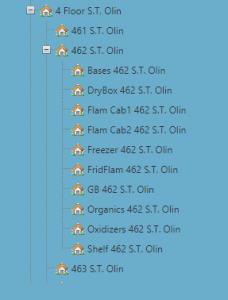Limitations on the Use of Chemicals in Research Facilities
Maximum Allowable Quantities (MAQs) and why are they important?
A Maximum allowable quantity (MAQ) is the maximum amount of hazardous material that may be stored or used within a control area in a building. Materials with established allowable quantities generally constitute a physical or health hazard.
Examples of materials that pose a physical or health hazard. Definitions for each class of materials can be found here:
- Aerosols
- Cryogenic liquids
- Flammables and combustibles
- Organic peroxides
- Oxidizing materials
- Pyrophoric and water reactive
- Explosives
- Corrosives
- Highly toxic
- Toxic
MAQs were established to ensure that quantities of hazardous materials in a building or use area are within the safe operating levels for fire control and life safety. Limits are established by the New York State Fire Code and are specific to each hazard class. Adhering to established limits is essential for supporting the research enterprise and ultimately ensuring the safety of building occupants and emergency responders.
The principal Investigator (PI) is informed of the MAQ limits of the research control area during the POSHER review. It is the responsibility of the PI to set policies for inventory management which ensure that (1) limits are not exceeded and (2) group members are aware of the limits.
What is a control area?
A control area is a space within a building where hazardous materials are stored, dispensed, used or handled. Control areas are constructed with features that slow or prevent the spread of fire to and from other areas in the building, allowing for safe emergency egress and fire department response. The number of control areas on a floor may vary across University buildings. Your facility manager can address any questions you may have about the design of your primary work area and established control areas.
How are MAQs determined? Why are my lab’s MAQs different from my colleagues’?
The MAQ established for your research control area is based on a number of factors dictated by the design and functioning of the facility.
Some of these are described below:
- lab location (facility, floor, and number/presence of other control areas).
In general, MAQs of hazardous materials decrease with increased elevation in a facility due to challenges to emergency response and mitigation.
- whether a fire sprinkler system is installed throughout the building.
Sprinklers are a critical fire suppression and management tool. The absence of sprinklers throughout a facility significantly increases the likelihood of fire spread.
Facilities lacking a distributed sprinkler system have stricter MAQ limits than those that are fully sprinklered.
How do I know if I am compliant with my MAQs?
Groups are encouraged to manage and monitor their compliance with MAQs using the Vertere Inventory Management System (VIM). Each group should review the hazard classes used, store materials appropriately and designate storage sublocations for each hazard class in Vertere. Groups should then monitor the quantities of materials in each sublocation at established intervals and prior to ordering materials.
An example of Vertere inventory with sublocations:
Groups are further encouraged to promptly dispose of barcodes from spent containers and ensure that new materials receive barcodes prior to being placed into use.
During the re-inventory cycle, groups review all materials present in the research control area and determine if any need to be disposed of or donated to the Complex’s surplus management program.
Good Strategies for Managing Chemical Inventories
- Purchase smaller quantities of chemicals (i.e 500g instead of 1kg)
- Avoid purchasing duplicate chemicals and cases of material
- Purchase bulk solvents from the Chemistry stockroom using refillable flammable storage containers
- When possible, borrow and share chemicals between groups in the PSC
- Confirm that your chemical inventory is accurate
- Dispose of any expired or unneeded chemicals and update your inventory accordingly
What happens if I exceed an MAQ?
Exceeding an MAQ increases the risk of adverse events (fire, chemical exposure) and regulatory action for non-compliance (fines and stop work orders).
If your control area exceeds the MAQ, you will receive an email notification with a recommended corrective action. If the corrective action cannot resolve the MAQ exceedance, a representative from the PSC Facilities Team will work with the faculty member and department head to develop a corrective action plan.
Failure to resolve an MAQ overage could result in regulatory actions by state or local fire authorities. Such actions may include the levying of fines or revoking permits for activities conducted in the facility.
How do I know which of my chemicals are in a particular MAQ hazard category?
Material hazards are described in Section 2 of the Safety Data Sheet (SDS). Additional hazard information is also found in Sections 10 and 11 which provide reactivity/ stability and toxicological information, respectively.
My research needs require more chemicals than I am permitted. Can I increase my MAQ?
MAQs are largely determined by building construction therefore, it can be very costly to increase storage limits. Requests for chemical storage in excess of the MAQ will be addressed on a case-by-case basis. Please contact the PSCFM Facilities Management Team for assistance.

